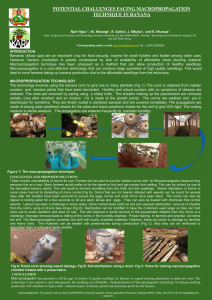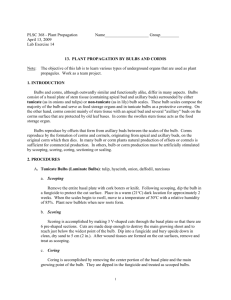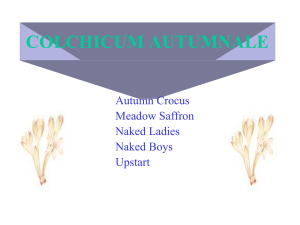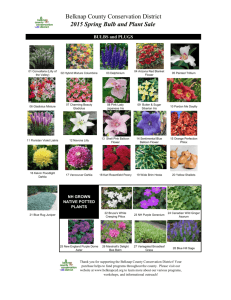Gladiolus Corms
advertisement
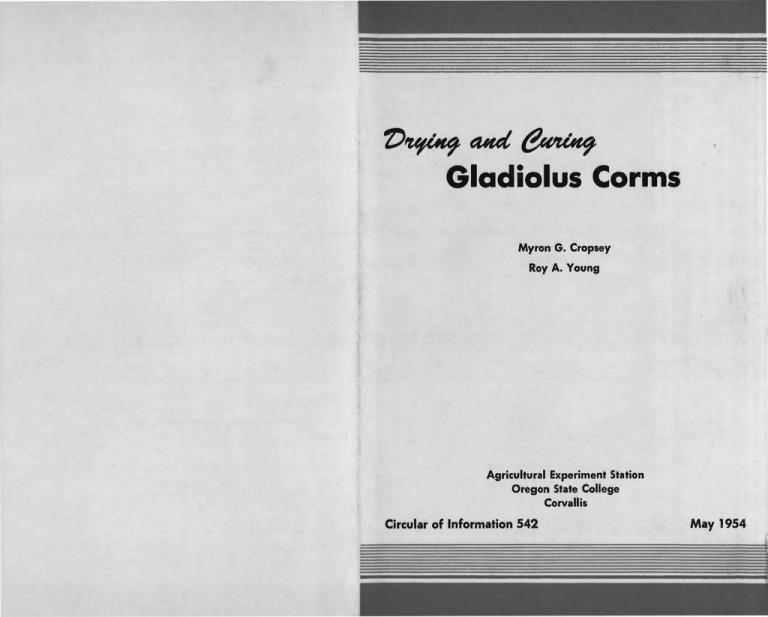
Gladiolus Corms Myron G. Cropsey Roy A. Young Agricultural Experiment Station Oregon State College Corvallis Circular of Information 542 May 1954 VrqiKf and gutut? Gladiolus Corms MYRON G. CROPSEY AND ROY A. YOUNG Gladiolus corm rots developing in storage cause growers many thousands of dollars in loss annually. These rots are caused by fungi that may be present at digging time on gladiolus leaves and flowers, in the soil around corms, and in or on the corms when they are dug. Corms may become infected in the soil during the growing season, during the process of digging, or in storage. Botrytis and Fusarium species are the principal causes of gladiolus storage rot in Oregon. Digging early in the season to avoid the build-up of Botrytis on gladiolus foliage, and curing corms at high temperature is the best means of preventing storage rots. Curing at high temperature has a twofold effect in preventing disease development: (1) curing stimulates development of a disease-resistant, corky layer on the surface of the corms; (2) curing at temperatures in excess of 90° F. kills some of the rot fungi that are present on the surface of corms, and in the husks, thus removing a source of infection. If corms are cured immediately after digging, then stored under proper conditions, loss from storage-rot diseases can be minimized. This circular presents information to emphasize the importance of proper curing in preventing development of corm rot in storage and discusses methods of obtaining desirable levels of temperature and humidity in storage houses. What happens when gladiolus corms are cured In the process of curing gladiolus corms: (1) the corms ited in the outer layer of cells, giving the corms a protective sive water loss and infection by rot-producing fungi; (3) cork (4) an abscission layer develops at the base of the new corm, the old corm. lose water; (2) suberin is deposcovering that prevents exceslayers develop around wounds; cutting off the new corm from How long should corms be cured Rate of curing depends primarily on the temperature and humidity at which corms are cured and upon the condition of corms when dug. If corms are excessively muddy, more time will be required for proper curing. When corms are dug during warm, dry weather, outside temperatures may be adequate for curing; however, if corms are dug during cool, wet periods, artificial curing is usually necessary. The following points are important in determining the length of time required to properly cure gladiolus corms: ► Degree of maturity of corms when dug. ► Temperature and humidity of the storage during curing. ► Size of the corm. ► Amount of wet soil on corms at digging time and bringing into storage for curing. When is a corm cured The amount of moisture loss is used as a criterion generally to determine when a corm is cured. However, moisture loss cannot be determined without taking weights. It is probably more practical to use the development of the abscission layer to measure when a corm is cured, considering the corm cured when the new corm separates easily from the old corm below. Corms can be cleaned readily at that time, but are difficult to separate if not cleaned immediately. The cleaned corms can then be subjected to two or three days (up to a week, if needed) of additional drying to provide for further thickening of the basal plate on the corms. Temperature The best temperature for drying in most gladiolus storage houses in Oregon is 80° F. At 70° F. corms dry too slowly and development of storage rots is not retarded. A temperature of 90° F. will result in faster drying, with less storage rot, and at 95° F. some rot fungi are actually killed. However, if temperature levels of 95° F. are used, the relative humidity must be maintained at 80 per cent or more to avoid injury to the corms. There is danger, also, that some of the incoming air direct from the furnace or heater will be hotter than 95° F. , causing injury that will result in delayed germination, or actually killing the corms. Also, high temperatures may be excellent treatment for those corms that are drying, but will perhaps overdry corms that are already in the house and have been dried. Finally, it is difficult to maintain the average storage house at 90° F. unless the house is insulated. To avoid injury during drying, the temperature of incoming air from furnace or stove should be checked and care taken that blasts of warm air directed upon the corms are not above 95° F. Severe burning of corms has taken place at 104° F. in tests at Oregon State College. TABLE 1. Natural infftntinnH Method of handling Amount of storage rot in corms Dried 23 hours 95° F. Dried in commercial in special drier, storage at 65-70° F. stored at 50° F. for 20 days Per cent Washed before drying, turned once during drying Turned once during drying Washed before drying No treatment other than drying 1.7 1.7 1.35 3.5 Per cent 5.8 4.5 It is likewise important that the air be sufficiently warm. Temperatures of 70° F. and below result in very slow drying and permit the development of rot. In experiments conducted at Oregon State College, three times as much drying time was required to dry corms at 70° F. as at 90° F. The faster the corms were dried, the less storage rot developed. (See Table 1.) No bad results were observed at 95° F. when the humidity was kept high. About 20 per cent of the original moisture should be lost during the drying period. Moisture losses in excess of 30 per cent cause the corms to appear shrunken and shriveled. Also, it has been reported that flowering has been reduced when moisture losses were excessive. Humidity The curing temperature determines the relative humidity to be maintained. The following relative humidities are recommended: Curing at 70° F. average above 30% relative humidity. Curing at 80° F. average above 50% relative humidity. ► Curing at 90° F. average above 80% relative humidity. It is relatively easy to average above 30 per cent relative humidity when curing at 70° F. The average fall temperature during digging is fairly close to 50° F. and 60 per cent relative humidity in Western Oregon. A temperature rise of 20° F. will not lower the relative humidity to any extent when drying is going on in the storage. Generally, the opposite is true—the humidity may be too high and slow drying will take place. Five to seven air changes per hour are necessary.* At 80° F. drying is more rapid and relative humidity should not average below 50 per cent. If the average humidity is below 50 per cent at 80° F., drying will occur. Limiting the air exchanges to between 5 to 6 per hour will generally control the humidity.* Drying at 90° F. occurs very rapidly, therefore the humidity should not average below 80 per cent relative humidity. The air exchanges should be limited to 3 to 4 per hour. Even with those low rates of exchange, it is sometimes necessary to boil water to increase the moisture content of the air. If high temperatures are maintained, moisture condenses on windows and thin walls due to differences of inside and outside temperatures. Double windows and insulated walls help prevent condensation. A vapor barrier on the warm side of the insulated walls will prevent the wood inside the walls from becoming wet and rotting. Perhaps the best way of curing at 90° -95° F. is to use a separate insulated room to hold corms dug each day. A great deal of the drying could be accomplished in this type of room in 24 hours; then corms could be slowly dried in the main storage. Inexpensive hair or wood hygrometers give indications as to the relative humidity of the air, although accumulations of dust and changes due to age tend to make these instruments inaccurate. Checking the hygrometer occasionally with a sling psychrometer will determine the true reading. TABLE 2. EFFECT OF DELAY IN DRYING ON INCIDENCE OF STORAGE ROTS Treatment Inoculated and 1. Dried immediately 2. Dried after 48 hours 3. Dried after 5 days 4. Dried after 15 days Rot after 5 months' storage (type of inoculation before storage) Botrytis Fusarium Per cent Per cent 8.2 11.4 16.1 31.8 See discussion under air circulation as to how air exchange is procured. 11.4 14.0 16.3 28.0 Figure 1. Two types of psychrometers. These instruments can be used to measure relative humidity accurately and can be used as a check on hair and wood hygrometers. The one on the left should be in an air stream of about 900 feet per minute to read accurately. The one on the right is a sling psychrometer. By whirling it around in the air by hand accurate readings are obtained. Air circulation Air circulation in a gladiolus storage is of three types: ► Distribution of air from the heating plant throughout the building. ► Circulating air around and among the gladiolus trays. ► Exhausting the air to the outside. A furnace with flues and fans can force air to various parts of a building. The discussion under construction of gladiolus storages gives details on size of flues to use. A common heater will require fans to push the air to the desired locations. There should be fans to circulate air around the new corms coming into the building. This seems to be beneficial up to air speeds of 200 feet per minute. Speeds beyond this do not result in faster rates of drying. Ordinarily some portable fans are required for this function. Guards should be placed in front of these fans to prevent accidents to workers. A certain amount of air has to be exhausted every hour to remove the excess water coming from the gladiolus corms. The amount of air that needs to be changed depends upon the humidity to be maintained. To determine the fan size to obtain a given air change, find the volume of the house in cubic feet, multiply by the number of air exchanges per hour desired, then divide by 60. This will give the fan size in cubic feet per minute. An exhaust fan should be located near the high point of the ceiling on an end wall. Try to make use of the prevailing winds to aid the fan. With every exhaust fan there must be an equivalent intake. Usually an opening on the opposite side of the building the same size in area as the fan is satisfactory. Both the fan and intake should be protected from driving rains by canopies on the outside. Turning of the gladiolus corms Gladiolus corms coming in wet from the fields in trays approximately 3 5/8" in depth are in a compact mass due to the mixing together of mud and small and large corms. Corms in the center of this compact mass do not dry. In experiments carried out at Oregon State College, less rot developed when the corms were stirred either once or twice during the drying period. Corms were stirred by reaching in with the hand and moving the corms around until those in the center of the compact masses were exposed to the air. Such stirring definitely increases the rate of drying, especially during the first week. If corms are relatively dry and free from dirt, stirring may not be essential. TABLE 3. EFFECT OF STORAGE TEMPERATURE ON DEVELOPMENT OF STORAGE ROTS Treatment 40° F. Corms rotted at 50° F. 60° F. Per cent Per cent Per cent Inoculated with: Botrytis Fusarium Uninoculated 76 27 1 24 86 10 54 99 16 Washing the gladiolus corms In tests, washing gladiolus corms decreased the rate of development of gladiolus corm rot. (See Table 1.) There seems to be no great difference in the amount of rot in washed lots or lots stirred once during the drying period when dried at 70° F. However, sufficient data are not available to recommend washing corms. Delay after harvest It has been found that best results are obtained if corms are dried immediately after digging. Any delay in curing at this time results in an increase in storage rot (Table 2). Storage temperatures The best storage temperature after curing seems to be about 50° F., since the amount of storage rot was lower at 50° F. than at 40° F. , or 60° F. At 60° F. the corms had a tendency to start rooting, although it was not excessive. Storage temperatures should not go below freezing. Summary of suggestions for curing gladiolus corms ► Dry corms as soon as possible after digging. ► Cure corms at as high a temperature as facilities will permit, up to 95° F. However, a temperature of 80° F. will probably be more practical in the average storehouse. ► Circulate air over corms being cured to prevent condensation of moisture on their surfaces, also to increase rate of drying. ► Do not allow humidity during curing to 30% relative humidity for 70° F. 50% relative humidity for 80° F. 80% relative humidity for 90° F. ► If corms are dirty or muddy, turn them within the trays at least once or twice during the initial drying period, exposing each corm to circulating air. This is not so essential if corms are dry and clean. ► Remove roots and old corms as soon as old and new corms separate readily. Following cleaning, new corms should be held at curing temperatures for two or three days (up to one week, if needed) to provide for additional thickening of the basal plate of the new corm. ► After curing, corms should be stored at approximately 50° F. for the remainder of the storage period. average below: temperature temperature temperature Construction of a Gladiolus Storage An ideal arrangement for gladiolus storage is a building with two floors, as shown in Figure 2. The heating system is at one end of the building in a room so constructed that if a fire breaks out it can be confined to that section of the building. During the early part of the digging season, the first corms dug can be placed on the first floor and heat directed into the various flues in this portion of the building. Later on, as more corms come in, they can be placed on the top floor and the dampers of the flues of that floor can be opened. The first floor can remain cool by closing the dampers in the flues leading to that floor. The length of the building determines the area of the cross-section of the flues. Attention is called to Table 4, which lists the cross sections of flues for buildings of various lengths and widths. The size of flues can be calculated from this table. For example, if a building is 30 feet wide and 40 feet long, with 2 double rows of trays 60" wide, how large should flues beneath the trays be made? From Table 4 it will be seen that a building 40 feet long by 30 feet wide would require 4 square feet of flue area. Two double rows would require 2 square feet per row. If the double rows of racks are 60 inches (or 5 feet) wide, and if the flues rim full width of the racks, then 2 feet of flue area divided by the width of row in feet is equal to the height of the flue or .4 feet. It would perhaps be best to use a 5-inch high flue beneath each row of trays. These could take up the entire width beneath each rack. Hot air should not pass up through the top of the flues, but should escape through 3/4" holes drilled in the side of the flues. This is done to prevent hot air coming directly from the furnace from striking and burning the corms. Cold air returns should be located in the end walls next to the furnace to permit the air to return to the furnace. Air can be blended in the furnace room with the proper amount of inside warm air and outside cool air by a window in this room. Each individual flue can be shut off by dampers, thus directing heat to the desired part of the building. Table 5 lists the required size of heating plant to maintain an average storage temperature of about 80° F. with the average fall weather common in Western Oregon. For ideal conditions, the furnace should be thermostatically controlled to be sure temperature does not become excessive in the flues. Fire-safe construction The construction of this storage house places the heating room at one end of the building. The section between the storage proper and the heating room should be lined with asbestos and galvanized iron. This is advised to confine accidental fires in the heating room. As an additional precaution, the roof of both the heating plant and the main storages should be covered with asbestos, or some other similar type of fire-resistant material. Normally, the gladiolus digging period is in the fall of the year before the rains start. The weather may be dry; consequently, the roof may very easily become ignited. A fireproof roofing material will tend to prevent a possible fire due to sparks falling on the roof. The chimney is placed on the foundation or ground in the heating room which eliminates a source of fire. Oil, wood, sawdust, or whatever material is used for heating, should be so arranged that it will not become ignited from heat or sparks originating from the furnace. TABLE 4. SIZE OF FLUES Width of building 20 Feet Length of building in feet 40 60 80 100 Square feet in cross section of flues 15 20 30 35 40 45 50 3 3 TABLE 5. 3 4 4 4.7 5.3 6 6.7 4 6 7 8 9 10 5.3 8 9.3 10.6 12 13.3 SIZE OF HEATING PLANT REQUIRED FOR AVERAGE GLADIOLUS STORAGE Inside volume of storage Size of heating plant in B.T.U.'s per hour Cubic feet B.T.U. 5,000 10,000 20,000 30,000 50,000 100,000 25,000 50,000 lao.ooo 150,000 250,000 500,000 The above assumes that the average outside air temperature is 40O F. , that tne coefficient of heat transfer of the walls is . 25 BTU Hr square feet per F0, and that there are 5 air changes per hour. 10 11.7 13.3 15 16.7 FIRE-RESISTANT ROOF COLD AIR RETURNS 7 2 X2 2X2 ^ ■ iitmn immutunmtnirnim JnftT XB. SIDE •"^TbR jEXHAUST : FANS ELEVATION S I (0 FLUES BENEATH GLADIOLUS RACKS COLD vjtutmirrnntnnntturytminiiiiitirrirr AIR AISLE RETURNS^ GLADIOLUS RACK AISLE GLADIOLUS RACK to CM N N K DOOR AISLE GLADIOLUS RACK EXHAUST HOLES AISLE zzz GLADIOLUS RACK AISLE ^A i fit fir 1/ > i t i / > > > n unit i , J, in i if i i\ PLAN HOIST SHAFT EXHAUST I (HOL ES *! T* FLUES -*--> i BENEATH ^HT RACK GLADIOLUS RACKS SECTION A-A FIGURE 2. SUGGESTED METHOD OF BUILDING GLADIOLUS STORAGE HOUSE
